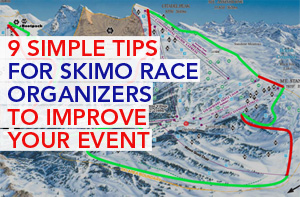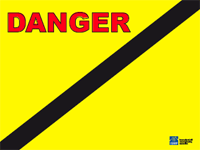 As a long time racer, organizer and a course designer I figured this would be a good time to share some of my thoughts with skimo race organizers on how you can easily improve your “customer” experience.
As a long time racer, organizer and a course designer I figured this would be a good time to share some of my thoughts with skimo race organizers on how you can easily improve your “customer” experience.
Skimo is still a niche sport but it will remain as such unless we up the ante. From what I am hearing or seeing we can learn a lot from other mountain sports about how to run things better.
In order of priority, here are 9 quick tips I hope you will find useful. And for some, I am talking from my own mistakes 😉
1. Release race entry fees and other info sooner
To illustrate, here is what a regular Colorado racer emailed me:
One flaw in the skimo racing scene is that registration information is not available far enough in advance. Trail racing in the summer is more organized in this regard. […] so that is an area the sport can focus on for improvement. It helps with planning and budgeting! – Jeremy
I believe he is not the only one with the same opinion.
2. Get Twitter or Facebook account if you don’t have a website
![]() As a web designer and online marketing consultant, I know websites can be a pain to keep up to date unless you are tech savvy. No problem, just get either a Twitter or a Facebook account with your event’s name and you are online and connected.
As a web designer and online marketing consultant, I know websites can be a pain to keep up to date unless you are tech savvy. No problem, just get either a Twitter or a Facebook account with your event’s name and you are online and connected.
Should you have problem about spreading the news that you now have an online presence just send me an email and I will do it for you.
3. Clearly communicate locations & times
Organizers seem to sometimes fail to make it easy to find key event’s locations and times. To say that start & finish will be located “to the right of Wild Bill’s Pub” might be enough for locals, but for those that spent $100 just to get there it would be useful to put up some posters or flags that navigate them to the right spot.
Locations and times for these are important:
- Race package pickup
- Pre-race meeting
- Start & finish area(s)
- Toilets
- Runs open for training/warming-up
4. DO NOT rely on local knowledge, mark the course well
Obviously, this is a no-brainer but it’s often taken too lightly. Again, here’s a quote from another Skintrack reader that illustrates this, and I myself have personally voiced to organizers many times over the years.
A pre-race meeting where you tell us to “make sure you turn left onto Hilda’s Headwall” and “loop around the avalauncher and then go up Thigh Burner under Chair 3″ is utterly useless to those racers who don’t live and breath your particular ski area. Also, make sure course marshals know the course and are alert to direct skiers to the right place. – Andy (regular Colorado racer)
5. Use standard colours for course markers/flags
A North American invention brought course marker colours skimo has never seen before. Long before ISMF (International Ski Mountaineering Federation) was established and brought standardization into racing, Europeans (the birth place of skimo racing) were using green flags for ascents and red flags for descents.
Why those?
Because red can be easily seen at high speeds while fluorescent green is a good contrasting colour to the mostly white-blueish environment, and is different enough from red.
Lots of NA races use red for going up and blue for downhills. The “logical” reasoning for this has always absolutely amazed me – ” when you are going up you are hot and red symbolizes this; when you are going down you are cold hence the blue colour”.
When racer is skiing at 40 mph it’s bloody hard to see red, never mind blue!
6. Don’t have a choke place
You don’t want a race to be decided by designing a disadvantage situation on your course (say creating a line-up). It is critical to avoid having:
- boot-pack on a first climb (or at least the first 20-30 min)
- single skin-track on the first climb (or in first 15-20 min)
- highly technical skinning/climbing/skiing section early in the race
- very narrow place early in the race (only one ladder in Corbet’s Couloir in Jackson Hole works good enough cause it comes after 2h of racing)
- very small platform/space for transitions
7. Use danger/caution flags
 These are not necessary for most races, most years. But there are times/places, such as rocky sections or unexpected turns, where a caution flag can be very useful.
These are not necessary for most races, most years. But there are times/places, such as rocky sections or unexpected turns, where a caution flag can be very useful.
When racer damages his/her skis or misses a turn they will not be a happy customer.
If you want to print the flag to the right download this PDF that I borrowed from ISMF – DANGER FLAG 40×60
8. Have warm tea or a drink in the finish area
This would be a nice but not a must item. Usually it’s not a problem to pay the ski area $50-70 for couple of gallons of fresh tea to be delivered to the finish area once the first racer comes in.
And here is a cool Italian twist that people will love you for! Instead of putting sugar in it, squeeze in some oranges (say 3-4 per gallon) and I guarantee you there will be people asking what kind of tea did you brew 😉
9. Put placing column in results
This is a minor yet a simple thing to fix. In recent years I have noticed numerous race results (even online) with no “place” column – either none at all or formatted to the very right. These are hard to read.
Also, racers really appreciate to find results online within a day of the race, if not the day of!
Need help? Free consultation call
 For the love of this sport, I am going to offer you a one free 30 min consultation call, to anyone interested. To arrange please email me from this contact page.
For the love of this sport, I am going to offer you a one free 30 min consultation call, to anyone interested. To arrange please email me from this contact page.
Or you can ask in the comments below.
Thank you very much for reading,
Stano 😉


Stano says
EB, completely agree with you.
Rec course should not only be called “rec” because it’s shorter but mainly because it’s not too much technically challenging.
And I have been a victim to low coverage areas myself. This one was hard for me to deal with when trying to race for National Team spot or top 5 as there was no choice – you want to be the best you have to suck it up. But it’s though to fuck up your skis when you paid for them yourself yet skipping on work to be the best you can be. It’s a chicken/egg scenario 🙂
EB says
As a participant in skimo races since 06/07 I’ve seen a trend in events that I don’t think is helping grow the sport from the recreational side. The rec course may be shorter in length but typically still includes the knarly downhills and technical skinning of the long course. For someone new to the sport this can be very intimidating and will cause them not to even want to attempt an event. Since most races are occurring at ski areas, a steep groomer downhill and a non technical uphill skinning route is plenty of challenge. I know this causes extra work for the race director but it may increase participant numbers.
Additionally, during low snow years, I know we like to maintain a sense of adventure in our courses, however routing racers through thin coverage areas only leads to trashed equipment and disgruntled participants at the end given the cost of equipment and or repair…..Just some thoughts.
Stano Faban says
Peter and Jonathan – good points but lets not hijack the discussion to be only about gear rules 😉
In my opinion, for now, the gear required and rules around it should be as simple as possible in order to attract more people, yet they still should be clear. Same goes for other rules – very clear but less of them. Once we have 80-100 people regularly showing up at races then we can say “here are ISMF rules and that’s that from now on”.
But beyond racing rules there are many areas that either can attract people to attend or discourage them from coming (again).
Jonathan Shefftz says
So for rando race rules in a single paragraph – to be included on a race flyer or single-page race website – how about:
“Please note that you must wear a helmet on your head at all times (both for skinning up and skiing down) and you must also be completely self-supported during the race, i.e., no caching of any food or water, no gear ditching, and no other forms of outside assistance – except for psychological support from your cheering fans! Also, for the designated bootpack(s), your skis must be securely lashed to your pack (not carried by hand).”
Jonathan Shefftz says
I’ve been struggling with the poles rule — both figuratively and literally (i.e., in practice).
I wasn’t even aware that the rule had changed until I read Nina’s unfortunately experience with it:
http://ninasilitch.com/2013/01/30/skimoworld-cup-alpiniski-switzerland/
I agree that prohibiting recreationalists from leaning on poles isn’t very welcoming.
However, the safety rationale would seem to be that with lots of racers in close proximity, and in hypoxia-induced mania, if ski poles are allowed for balance at transitions, then violations could unwittingly occur of the prior prohibition of pole tips going above pole grips and thereby also going into … other racers.
The Powderkeg website also published this rule last year, along with a one-minute penalty for, “Not placing poles on ground during transition or picking up poles prior to completely tucking skins into race suit” — although some racers might gain more than a minute by violating that rule!
peter k says
^surprised you state the “poles rule” in there. In my opinion, it creates additional entry barriers for beginners. Pulling skins from the tails (like on most recreational setups) is pretty hard without balancing on ski poles. Have to be a little lenient on the ISMF rules (mismatched bindings, boot mods, telemark, splitboard, etc…) in NA to provide less resistance to racing. This info should be on the website! Is there going to be a zero tolerance for missing safety equipment, or is it merely a suggestion (Whitefish)? Good communication = less last minute registrations as well.
Jonathan Shefftz says
Also publish the rules — as well as have some sensible rules!
I think this greatly enhances pulling off a race that is safe, fun, and fair for all participants.
(Otherwise, all sorts of gamesmanship can ensue, like outside assistance, caching water, etc.)
My summary is posted here:
http://nerandorace.blogspot.com/2013/09/rules.html
(This is on my mind right now because I just learned that one ski area is really stepping it up for the second year of hosting a race, and although the course map is very nicely done — well, except for the unique neon pink ascent color! — the only rule is that you *can* just shoulder your skis for the bootpack, ugh…)
Stano Faban says
Andy, I have added your first point to the list because in a state of overwhelm I forgot about it, yet it’s something I have expressed myself in those exact words many times.
Thanks for paying attention 😉
Andy says
Thanks for posting these. Following your advice would make for a smooth racing experience. I have a few to add from my experience racing in Colorado:
-Make sure the course is well marked. A pre-race meeting where you tell us to “make sure you turn left onto Hilda’s Headwall” and “loop around the avalauncher and then go up Thighburner under Chair 3” is utterly useless to those racers who don’t live and breath your particular ski area. Make sure course marshals know the course and are alert to direct skiers to the right place. (I think there’s paint used in some skiing events…)
-Schedule events so that racers can show up! There are some racers in NA who are sponsored and have job flexibility to get out of other work whenever they want, but if we’re trying to get more people into the sport then races should be planned for weekend warriors. For example, we’re looking at the Wasatch Powder Keg on a Friday-Sunday and then racers need to be in a meeting CB the next Thursday evening at 7:30 if they want to race in US Nationals.
Also, I’m whining here because I think there are ways to do these races better, but I really want to thank race organizers – they do a great job and these races are a blast!